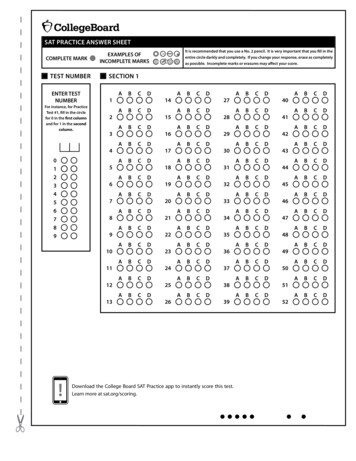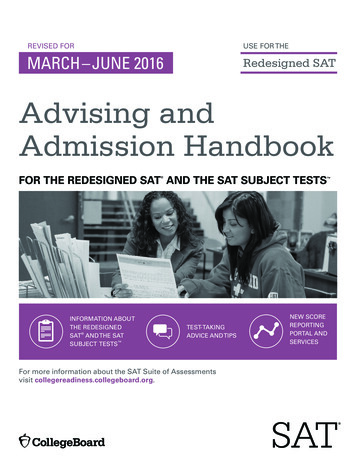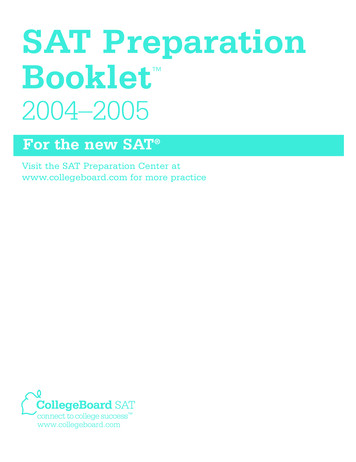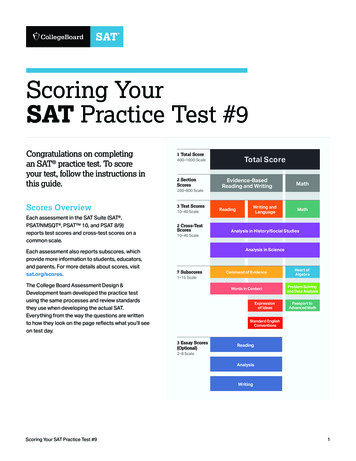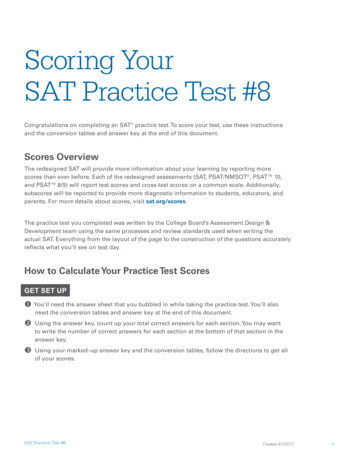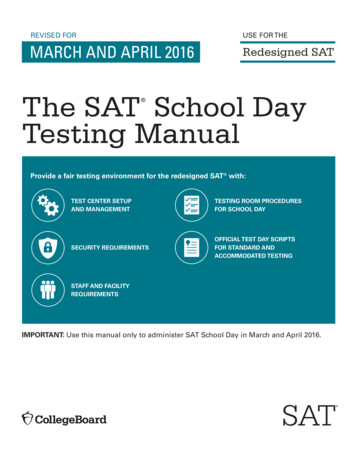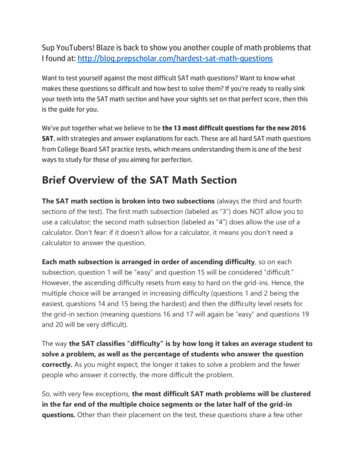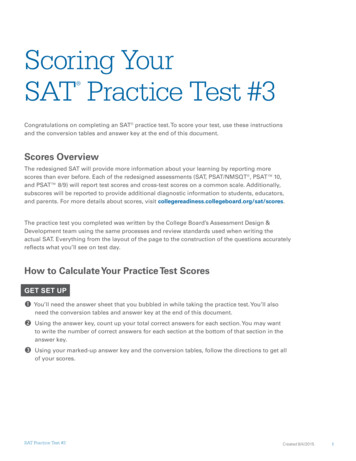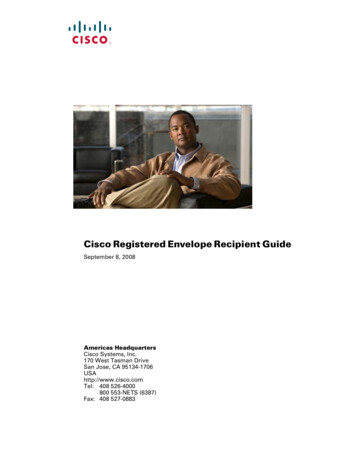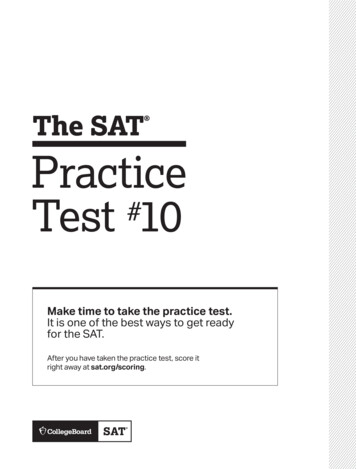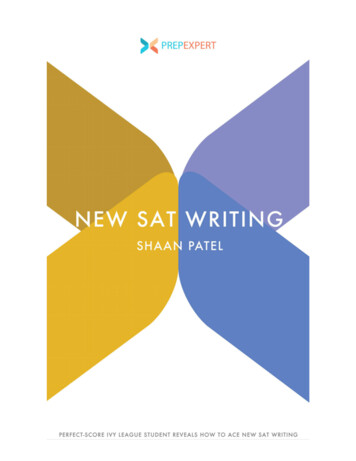
Transcription
Copyright (C) 2015 by Patel Educational Services, Inc. All rights reserved. Published in theUnited States of America. Except as permitted under the United States Copyright Act of1976, no part of this publication may be reproduced or distributed in any form or by anymeans, or stored in a database or retrieval system, without the prior written permissionof the publisher.SAT is a registered trademark of the College Entrance Examination Board, which was notinvolved in the production of, and does not endorse, this product.Enroll in a Prep Expert SAT or ACT Prep Course at www.PrepExpert.com
About The AuthorShaan PatelPerfect Score SAT Student, Valedictorian, & Homecoming KingWinner of 250,000 in Scholarships#1 Bestselling Published Author40 Under 40 Las Vegas 2015MD/MBA Student at Yale & USCShaan Patel is the founder of Prep Expert Test Preparation, a #1 bestselling SAT & ACTbook author, and MD/MBA student at Yale and USC. He raised his own SAT score fromaverage to perfect and teaches students his methods via online classes atPrepExpert.com
1SAT WRITING CONTENTS
SAT WRITING INTRODUCTION2We lcomeWelcome to the SAT Writing portion of the Prep Expert Course! Many students are under theimpression that SAT Writing is no longer a part of the New SAT. This false assumption stems fromthe fact that when the SAT was out of 1600 points previously (prior to 2005), it only had Math and Reading, but no Writing. However, on the redesigned 1600-version of the SAT, the Reading andWriting sections of the exam have been combined into one 800-point score. In addition, many studentsand parents are under the impression that the SAT Essay reflects your SAT Writing score. However, this isnot true. In fact, your SAT Essay does not affect your SAT Writing score at all.Here are the basics of what you need to know for the SAT Writing portion of the SAT.GrammarThe SAT Writing portion of the exam primarily tests grammar. This means you need to know how toproperly use pronouns, conjunctions, punctuation, etc. We will cover all of the grammar rules you needto know for the SAT. Most of the grammar rules have not changed all that much from the previous2400-verison of the SAT.ClarityThe SAT Writing portion of the exam now has a greater emphasis on clarity. More than ever, it is importantto understand the meaning of the Writing passages. You should determine whether the author is conveying her message in the clearest way possible. Clarity has to do with the author’s development, organization, and communication of ideas.
3SAT WRITING INTRODUCTIONEffective StrategiesOur goal with this section of the Prep Expert course is to give you effective strategies to tackle theSAT Writing section. After you learn all 20 Writing Expert Strategies, you should be well-prepared to tackleany grammar or clarity issue on the SAT Writing section.
5SAT WRITINGSAT ESSAY FREQUENTLY ASKED QUESTIONSFREQUENTLY ASKED QUESTIONSW H AT I S T H E F O R M AT ?1W H AT ’ S D I F F E R E N T ?2H O W I S S AT W R I T I N G S CO R E D ?3I S S AT W R I T I N G E A S I E R ?4WHY BE LITERAL?5W H Y I S S AT W R I T I N G N O W G R O U P E D W I T HS AT R E A D I N G ?6W H AT I S T H E B I G G E S T M I S TA K E S T U D E N T SM A K E O N T H E S AT W R I T I N G S E C T I O N ?7
SAT WRITING FREQUENTLY ASKED QUESTIONSWhat Is The Format?61SAT Writing FormatTime35 MinutesQuestions44 Questions Expression of Ideas 24 Questions Standard English Conventions 20 QuestionsPassages4 Passages (400-450 Words Per Passage) 1 History/Social Studies Passage 1 Humanities Passage 1 Science Passage 1 Career PassageThe second section of every New SAT will be a 35-minute Writing section with 44 questions.TimeYou have more time than ever on the SAT Writing multiple-choice portion of the exam. However,you also have more to read. Previous SAT writing multiple-choice questions were single, unrelated sentences. Now, you must make grammar and clarity corrections within the context of passages. Making sureyou understand these passages will likely take more time.
SAT WRITING FREQUENTLY ASKED QUESTIONS7QuestionsLuckily, there are fewer SAT writing multiple-choice questions than ever. However, most of thesequestions (24) are related to Expression of Ideas, or clarity. Clarity refers to how well an authordevelops, organizes, and conveys ideas. Many of the Reading Expert Strategies will be helpful inanswering the Expression of Ideas Writing questions. There are still 20 Standard English Conventionquestions, or grammar questions. We will teach all of the grammar rules you need to know to ace theSAT Writing section.PassagesThere will be one of each of the following passages on the SAT Writing portion of the exam: history/social studies, humanities, science, and career. This does not mean that you will need to answer a scienceor history question. Instead, your passage may be related to a science or historical topic, and you will beexpected to correct any clarity or grammatical issues related to it.
SAT WRITING FREQUENTLY ASKED QUESTIONSWhat’s Different?82There are some key differences between the new SAT Writing portion of the 1600-versionof the SAT and the SAT Writing section on the 2400-verision of the SAT.2400 SAT WritingNew SAT Writing800 Points400 PointsEssay 1/3 of ScoreEssay Not Included in ScoreIsolated SentencesPassagesIdentifying Sentence Errors &Standard English ConventionsImproving SentencesImproving ParagraphsExpression of IdeasYou might think that the SAT Writing section is less important than it used to be since it only accountsfor 400 points on the New SAT (compared to 800 on the old SAT). However, the multiple-choiceportion of the SAT Writing section actually makes up a larger percentage of your score than ever:400/1600 25%. 25% of your entire SAT score is due solely to writing multiple-choice questions.On the previous 2400-version of the SAT, the writing multiple-choice section only made up 22% ofyour entire SAT score. Because the SAT Essay accounted for 1/3 of your SAT Writing score out of800, the multiple-choice portion of the Writing section was only worth 530 points. 530 points out of2400 is 22%. Therefore, answering questions correctly on the SAT writing multiple-choice portion ofthe exam is now more important than ever.One of the ways that you will be able to answer questions on the SAT Writing correctly is toimprove your ability to comprehend passages. We will teach you how to do this in the SAT Readingsection. Unlike the 2400-version of the SAT in which almost all of the Writing questions were isolatedsentences, the new format of the exam requires that students be able to correct sentences within
9SAT WRITING FREQUENTLY ASKED QUESTIONSpassages. Without fully understanding passages, students will have a hard time correcting thegrammar and clarity issues related to sentences. It is more important than ever that students perfectthe art of reading passages.Finally, there were two main types of questions on the 2400-version of the SAT: Improving Sentences andIdentifying Sentence Errors. These were isolated questions that essentially had students correct grammarissues. On the new 1600-version of the SAT, these grammar questions are categorized as “Standard EnglishConvention” questions. However, these questions will be mixed in with “Expression of Ideas” questions,which focus on clarity issues. These questions are similar to what the Improving Paragraphs section of theprevious version of the SAT had. Nevertheless, the content of the SAT Writing has remained largely thesame.
SAT WRITING FREQUENTLY ASKED QUESTIONSHow Is SAT Writing Scored?3You will receive many different scores on your score report related to SAT Writing.However, I would not pay attention to most of them, except your Evidenced-Based Reading & WritingSection Score out of 800 and your Total SAT Score out of 1600. But for the sake of completeness, Iwill review what each of the scores means here.Subscores (1-15)Standard English ConventionsThis subscore indicates how well you performed on grammarquestions.Expression of IdeasThis subscore indicates how well you performed on clarityquestions.Test Score (10-40)WritingThis subscore indicates how well you performed on all SATWriting and Language questions.Cross-Test Score (10-40)Analysis in ScienceThis cross-test score indicates how well you performed onscience passages and questions across the SAT Writing, SATReading, and SAT Math sections.10
SAT WRITING FREQUENTLY ASKED QUESTIONS11Analysis in History/Social ScienceThis cross-test score indicates how well you performed onhistory/social science passages and questions across the SATWriting, SAT Reading, and SAT Math sections.Section Score (200-800)Evidenced-Based Reading &This section score indicates how well you performed on bothWritingthe SAT Writing and SAT Reading sections together.Total Score (400-1600)Reading & Writing MathematicsThis is your SAT score out of 1600 that you will remember forthe rest of your life.
SAT WRITING FREQUENTLY ASKED QUESTIONSIs SAT Writing Easier?124The New SAT Writing section is easier than the SAT Writing section on the 2400-version of the exam.There are two primary reasons for this: less content and more time. On the new SAT, there is lesscontent a student has to know in order to do well. There are fewer grammar rules that you need tomaster. You also have about 5 extra seconds per question. While 5 seconds may not sound like alot of time, if you multiply that over 44 questions, you have a few extra minutes of time. In addition,there are only 4 answer choices per question (rather than 5 on the 2400-version of the SAT) leavingyou with even more time.The only aspect of the SAT Writing section that is now more difficult is that you have to readpassages throughout the section. Previously, students could get away with not fully understandingthe meaning of a sentence because that question would be isolated. However, notunderstanding a sentence (or worse, a paragraph) on the SAT Writing section can now be detrimental toyour score. It’s imperative that students master Reading Expert Strategies in order to ace the SAT Writingsection as well.
SAT WRITING FREQUENTLY ASKED QUESTIONS13Why Be Literal?5On the SAT Writing, it is crucial that you take everything literally. This means that you must not readinto anything the SAT has stated. Cut the SAT Writing section no slack. Whatever the text says is what itmeans. Nothing more, nothing less. Learning how to interpret passages literally is one of the best ways toimprove your SAT Writing score.The problem is that we have very bad habits of not taking things literally. In everyday language, we areaccustomed to not taking what a friend says literally. We do this because we know what our friendmeans. This cannot happen on the SAT. Assume that you have no idea about what the SAT Writingpassages are trying to say. Instead, you only know what they actually are saying. For example, take alook at the following sentence:Do you remember that time where Jason hiked to the top of the mountain?Now, if your friend said the above sentence to you, you probably wouldn’t blink an eye. Sounds likea fine sentence. However, on the SAT Writing section, there should be all kinds of alarms going off inyour head! “Where” is a relative pronoun that can only refer to geographic locations. You cannot use“where” when referring to time. Instead, you need to use the relative pronoun “when.” We will learnmore about this rule later. But for now, realize that SAT Writing errors are much easier to spot whenyour mind is thinking literally.Let’s try another example:
SAT WRITING FREQUENTLY ASKED QUESTIONS14It is amazing how colorful the sky is.Again, in everyday language this sentence sounds fine. However, on the SAT Writing section, you needto think literally. What is the “it” referring to? Unclear. The sentence may be improved by clearly statingthat “The colorful sky is amazing.”Let’s try one last example:I hope to win the art contest next year like Sarah’s masterpiece did this year.Once again, if a friend simply said this to you in everyday conversation, you wouldn’t think too muchof it. But on the SAT Writing section, the above sentence is absolutely unacceptable. Think aboutthe literal meaning of the sentence. The comparison being made is between “I” and “Sarah’s masterpiece.” Can you compare a person to a work of art? No! We must compare a person to a person ora work of art to a work of art. We will learn more about comparison errors later.In summation, a literal mindset will be essential to your success on the SAT Writing section. You must be astickler. Do not cut the SAT any slack. The text means what it says and that’s it. Nothing more and nothingless.
15SAT WRITING FREQUENTLY ASKED QUESTIONSWhy Is SAT Writing Now Grouped With SAT Reading?6You might be wondering why the SAT decided to combine the SAT Writing and SAT Reading sectionsrather than have each as a separate section like on the 2400-version of the SAT. Well, the primaryreason is that the SAT wanted to go back to a 1600-point format. In addition, it actually does makesense for the SAT to make this move because of how it has structured the new SAT Writing section.The SAT Writing section consists of questions that test Standard English Conventions and questionsthat test Expression of Ideas. Questions that relate to Standard English Conventions test sentencestructure, conventions of usage, and conventions of punctuation. These are essentially grammar questions that made up the bulk of the SAT Writing section on the 2400-version of the SAT.However, questions that relate to Expression of Ideas test development, organization, and effectiveuse of ideas. Because these questions now make up the bulk of the SAT Writing section (55%), itmakes sense that SAT Writing is now grouped with SAT Reading.Clarity questions are more similar to SAT Reading passage comprehension questions than they are togrammar questions. More than ever, mastering SAT Reading strategies will be essential to your success on the SAT Writing section.
SAT WRITING FREQUENTLY ASKED QUESTIONSWhat Is The Biggest Mistake Students MakeOn The SAT Writing Section?167The biggest mistake students make on the SAT Writing section is trusting their ears. You cannotselect answer choices based on what sounds correct. Most students who have never studied forthe SAT approach this section by choosing what sounds correct. This is a flawed approach. SAT testwriters are really good at making answer choices that sound terrible be correct and answer choicesthat sound good be incorrect. Do not trust your ear when it comes to the SAT Writing section.Instead, the most effective way to approach the SAT Writing section is to identify actual grammaticaland clarity issues on each question. When you approach a particular SAT Writing question, you shouldknow exactly what grammar rule or clarity rule is being tested. The only way to know this is to learnall of the writing issues that can appear on the SAT. Luckily, there is only a limited number of grammarand clarity rules that you need to know for the SAT. And we will teach you all of them.The way my mind works when I approach SAT Writing questions is by grouping questions into“buckets.” Buckets represent the category of issue that I believe the SAT is testing with a particularquestion. For example, I might group a question into the parallelism bucket, the tense bucket, theorganization bucket, or the idiom bucket depending on what rule I believe the SAT is testing.Grouping questions into “buckets” not only helps clarify the question for me, but it also increases myconfidence that I am answering the question correctly. If you have no idea what bucket a particularquestion falls into, then you really have no idea whether you are answering that question correctly.Group each question into a targeted bucket rather than flying blind.
SAT WRITING FREQUENTLY ASKED QUESTIONS17Passage ApproachI have already emphasized how important the ability to read and understand passages is to the SATWriting section. Therefore, I have dedicated this entire section to teaching the Prep Expert approachto passages. The problem with passage-based questions is that no one ever teaches you the bestway to read and comprehend a passage on a standardized exam. Yet, standardized exams are fullof passage-based questions. For example, here are just a few of the major standardized exams thatI have taken in my life that have had passage-based questions on them. SAT PSAT AP Exams SAT Subject Exams MCAT GMAT USMLE Step 1 & Step 2 (United States Medical Licensing Exams)Fortunately, I came up with an effective strategy to tackle passage-based questions early on in myhigh school career. This strategy served me well for many of the above exams. Many students are notso lucky. They simply do not have a strategy to tackle passage-based questions. Let’s examine someof the possible approaches students try on passage-based reading.
SAT WRITING FREQUENTLY ASKED QUESTIONSPossible Passage-Based Approaches(1) Questions-OnlyMy biggest issue with passage-based questions in high school was that I never had enough time. Iwas a slow reader and often couldn’t finish the section in time. So one of the first passage-basedapproaches I tried was to read only the questions associated with a passage and skip reading thepassage altogether. This would save a tremendous amount of time because I would only read partsof the passage that were related to particular questions. This strategy is particularly appealing forthe New SAT Writing section because many of the questions are asking about isolated issues inparticular sentences, rather than asking about the passage overall. Many students will choose thispassage-based approach for the New SAT Writing section. The problem with this strategy is thatstudents will not have a comprehensive understanding of the passage, which will be detrimental toanswering the Expression of Ideas questions that make up the majority of the New SAT Writingsection.(2) Questions-FirstAnother approach that many students will take with respect to the New SAT Writing section is to readall of the questions first, then read the passage. The theory behind this approach is that you will knowwhat to focus on while you are reading the passage since you have already read the questions. Thereare 11 questions associated with each SAT Writing passage. So a student would read 11 questions,read the passage, then answer the questions.The biggest problem with this approach is lack of time. You are essentially reading every questiontwice. This will take a significant amount of time that you simply do not have during a test like the SAT.In addition, trying to remember what 11 questions were about at once is no easy task. As you take theSAT, you can think of your mind being split into active memory and thinking power. The more itemsyou try to stuff into your active memory, the less thinking power you have. Trying to remember 1118
19SAT WRITING FREQUENTLY ASKED QUESTIONSquestions will use up a lot of active memory and decrease your thinking power, resulting in answeringmany questions incorrectly.(3) Passage-FirstAnother common approach that many students will use to tackle the New SAT Writing section is toread the entire passage first, then answer the questions. The theory behind this strategy is that if youhave a good understanding of the passage first, then answering the questions will be easier. Thisapproach is probably the most common approach to tackling passage-based questions in generalamong high school students. It makes sense: read the passage first; read the questions second.However, the major pitfall with this strategy is once again time. This approach requires extra reading.You read the passage once, but when you get to the questions, you will often have to reread theparts of the passage that the question is referring to. In addition, you are trying to remember thatentire passage that you just read. Your mindset is “I just read that entire passage, so I’m not goingto let myself forget it.” Once again, doing this takes up space in your active memory during the exam,which results in decreased thinking power, and increased incorrect questions.So if none of the above passage approaches works, what does? Finally, I figured out the bestapproach for me in high school, and I think it will also be the best approach for you.
SAT WRITING FREQUENTLY ASKED QUESTIONSChunk ApproachThe chunk approach allows us to both save time and understand passages better. I know it soundstoo good to be true. But before I explain the Chunk Approach, I will warn you that it is going to besomething you probably haven’t done before. Therefore, it will not be comfortable to implement.Breaking old habits is never easy. You will likely have some resistance to using the Chunk Approachat first. You will want to answer passage-based questions using the strategy you have always used.But remember that if you want to change your score, you have to change the way you take the test.So please give the Chunk Approach a try.Here is how the Chunk Approach works for the SAT Writing section:(1) Find PKP(2) Answer Questions Associated with Paragraph 1(3) Read Paragraph 2(4) Answer Questions Associated with Paragraph 2(5) Read Paragraph 3(6) Answer Questions Associated with Paragraph 3(7) Repeat Until You Have Answered All QuestionsEssentially, the Chunk Approach has you reading bite-sized pieces of the passage. On the New SATWriting section, these pieces are 1 paragraph long. After reading each paragraph, you then answerthe question(s) associated with that particular paragraph. In other words, the Chunk Approach with20
21SAT WRITING FREQUENTLY ASKED QUESTIONSrespect to the New SAT Writing section is really just a Paragraph Approach. This will change slightlyfor the SAT Reading section, but the concept behind the Chunk Approach will remain the same.The biggest benefit of using the Chunk Approach is that it reduces the amount of information yourbrain has to process at once. One of the biggest challenges I ran into when I was trying to acepassage-based questions in high school was the amount of information I had to absorb at once. Iwould often be overwhelmed with the amount of reading I had to do. With the Chunk Approach, yourreading has been chopped down into discrete paragraphs. This is advantageous because you canfocus on the ideas presented in a single paragraph. With respect to SAT Writing, you can also focuson the particular questions associated with a single paragraph. This is much less overwhelming thantrying to store an entire passage at once in your active memory, which would leave almost no thinkingpower for you to answer questions.The Chunk Approach also prevents a lot of rereading. Imagine the opposite “Passage-First” Approach.In the Passage-First Approach, you read the passage once in the beginning and then reread parts ofthe passage that you already read as you answer questions because you probably forgot whatparticular parts of a passage were about. With the Chunk Approach, the amount of rereading thatyou need to do is significantly reduced. Because you are so focused on a particular paragraph’sideas, you don’t need to reacquaint yourself with the context of the passage when you are answeringa question.If you are concerned that the Chunk Approach won’t be effective when you have to answer moregeneral questions such as those that relate to the main topic of a paragraph or conclusion of thepassage, there is no need to worry. Even when you have to answer general questions that are not necessarily attached to a specific sentence, the Chunk Approach is useful. For example, let’s saythat a question asks you about the conclusion of the SAT Writing passage. The Chunk Approachfully equips you to answer this kind of question because you just read the entire passage paragraphby-paragraph. Your understanding of the overall passage should be solid enough to answer thequestion related to the conclusion.
SAT WRITING FREQUENTLY ASKED QUESTIONS22Use the Chunk Approach on every SAT Writing passage that you come across from now on. There are fourwriting passages on the SAT, each with 11 associated questions. And you should break down every one ofthose passages into manageable paragraphs that you can easily analyze.The only exception to the rule of reading 1 paragraph at a time is when you are answering a questionthat asks about the last sentence of a paragraph. When dealing with the last sentence of a paragraph,you should always read the beginning of the next paragraph. The SAT will want you to transition between paragraphs appropriately. If you haven’t read the next paragraph, it will be difficult to transitionbetween the two paragraphs.As you may know, I really believe in teaching through examples. So below is an SAT Writing passagethat we will apply the Chunk Approach to throughout this section of the course.Expert Example SAT Writing PassageOccupational InjuriesCounting of occupational injuries and illnesses 1 are complex; potential issuesincludes employee fear about reporting, lack of employer awareness of reporting requirements,complex definitions of workplace injuries, difficulty determining whether an injury actuallyoccurred at work or is otherwise work related, 2 having disputes over responsibility,measurement issues, and more. The Bureau of Labor Statistics provides the nation’s officialstatistics on workplace injuries and illnesses, including estimates of the number and rate ofnonfatal injuries and illnesses by industry and state and, for selected cases, details about theworker involved and the circumstances of the incident. These data are based on OccupationalSafety and Health Administration (OSHA) guidelines, 3 set of definitions and explanationsused by employers nationwide, and to maintain workplace safety records for their establishment. The Occupational Safety and Health Act of 1970 (the OSH Act) requires employersselected by BLS to maintain these records, which are used by employers to complete the annual
SAT WRITING FREQUENTLY ASKED QUESTIONS23Survey of Occupational Injuries and Illnesses (SOII). From time to time, the completeness ofthe SOII estimates has been examined, most recently through a series of BLS-sponsoredresearch projects. The goals and results of that research are 4 this articles subject.More than once since its inception in the early 1970s, 5 the BLS occupational safetyand health statistics program has been the subject of scrutiny, often leading to programchanges. 6 Next, concern in the late 1980s that a sample survey could not provide a completecount of workplace fatalities led to the development of the BLS Census of Fatal OccupationalInjuries (CFOI), which has provided a comprehensive count of fatal work injuries annuallysince 1992. Also in 1992, BLS expanded the SOII to include “case and demographic” details.7 These data elaborate on the worker involved (including occupation, age, and gender) andthe circumstances surrounding the incident (including nature of injury and part of bodyaffected). Since 1992, case and demographic data have only been available for cases that resultin at least 1 day away from work, although BLS recently began publishing the results of pilottests of 8 it 9 for: cases that result in no days away from work but lead to a job transfer orrestricted work.Concerned about BLS workplace injury and illness data in the mid-2000s,10 individual cases were attempted to be combated by researchers from the SOII inselected states with case data from state workers’ compensation records. The results varied,with estimates of an undercount ranging from 20 percent to 70 percent of cases dependingupon the research methodology and state studied. Other research and analysis concluded thatthe size of the undercount is small. On the heels of this research, and media reports of unsafework places, Congress held hearings on the subject and later identified funding for BLS tofollow up and expand on the previous research so as to understand the nature and magnitudeof any undercount and attempt to identify solutions. At the same time, Congress providedfunding to OSHA and to the National Institute for Occupational Safety and Health to conductcomplementary research into issues surrounding the completeness of work injury data.
SAT WRITING FREQUENTLY ASKED QUESTIONSBLS staff, several state agencies, and one university researcher conducted this initialround of research over 3 years. At that time, BLS convened to hear presentations on researchresults and to develop consensus recommendations for moving forward. Interestingly, 11Massachusetts (MA) reported results lower than the national average.24
SAT WRITING FREQUENTLY ASKED QUESTIONS25Find PKPAs you may remember from the SAT Essay section, PKP stands for the Passage’s Key Point. Onthe SAT Writing section, it’s crucial that we start attacking each passage by finding the PKP.Clarifying the main idea of the passage at the beginning will make life so much easier as we tacklethe associated questions. Remember that you can typically come up with a good PKP after readingthe first paragraph of a passage. If you are unable to synthesize a PKP after reading the firstparagraph, you should either continue reading into the second paragraph until the PKP becomesapparent or restart from the top in case you zoned out.There are two benefits to physically writing down a PKP for the passage. First, comprehension ofthe passage increases because you will have a central theme to focus around. Second, answeringquestions will become easier because many of the Expression of Ideas questions are related to themain idea of the passage.Let’s practice finding the PKP on our Expert Example SAT Writing passage.Counting of occupational injuries and illnesses 1 are complex; potential issuesincludes employee fear a
Shaan Patel Perfect Score SAT Student, Valedictorian, & Homecoming King Winner of 250,000 in Scholarships #1 Bestselling Published Author 40 Under 40 Las Vegas 2015 MD/MBA Student at Yale & USC Shaan Patel is the founder of Prep Expert Test Preparation, a #1 bestselling SAT & ACT

